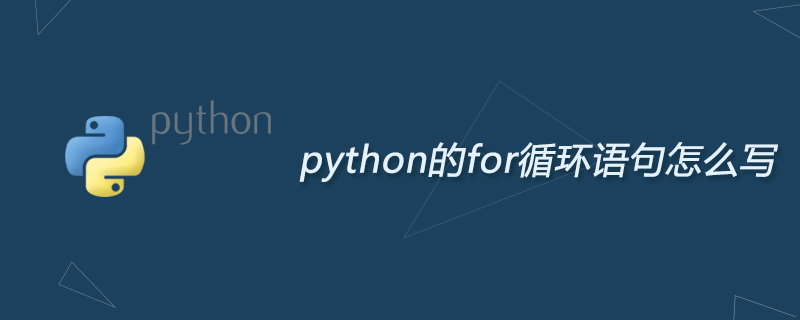python的for迴圈語句怎麼寫
Jul 04, 2019 am 10:54 AM
python

python的for迴圈語句怎麼寫?
Python for迴圈可以遍歷任何序列的項目,如一個列表或者一個字串。
語法:
for迴圈的語法格式如下:
for iterating_var in sequence: statements(s)
登入後複製
實例:
實例
#!/usr/bin/python # -*- coding: UTF-8 -*- for letter in 'Python': # 第一个实例 print '当前字母 :', letter fruits = ['banana', 'apple', 'mango'] for fruit in fruits: # 第二个实例 print '当前水果 :', fruit print "Good bye!"
登入後複製
以上實例輸出結果:
当前字母 : P 当前字母 : y 当前字母 : t 当前字母 : h 当前字母 : o 当前字母 : n 当前水果 : banana 当前水果 : apple 当前水果 : mango Good bye!
登入後複製
透過序列索引迭代
另外一種執行循環的遍歷方式是透過索引,如下實例:
實例
#!/usr/bin/python # -*- coding: UTF-8 -*- fruits = ['banana', 'apple', 'mango'] for index in range(len(fruits)): print '当前水果 :', fruits[index] print "Good bye!"
登入後複製
以上實例輸出結果:
当前水果 : banana 当前水果 : apple 当前水果 : mango Good bye!
登入後複製
以上實例我們使用了內建函數len() 和range(),函數len() 傳回列表的長度,也就是元素的個數。 range傳回一個序列的數。
循環使用else 語句
在python 中,for … else 表示這樣的意思,for 中的語句和普通的沒有區別,else 中的語句會在循環正常執行完(即for 不是透過break 跳出而中斷的)的情況下執行,while … else 也是一樣。
實例
#!/usr/bin/python
# -*- coding: UTF-8 -*-
for num in range(10,20): # 迭代 10 到 20 之间的数字
for i in range(2,num): # 根据因子迭代
if num%i == 0: # 确定第一个因子
j=num/i # 计算第二个因子
print '%d 等于 %d * %d' % (num,i,j)
break # 跳出当前循环
else: # 循环的 else 部分
print num, '是一个质数'登入後複製
以上實例輸出結果:
10 等于 2 * 5 11 是一个质数 12 等于 2 * 6 13 是一个质数 14 等于 2 * 7 15 等于 3 * 5 16 等于 2 * 8 17 是一个质数 18 等于 2 * 9 19 是一个质数
登入後複製
相關推薦:《Python教學》
以上是python的for迴圈語句怎麼寫的詳細內容。更多資訊請關注PHP中文網其他相關文章!
本網站聲明
本文內容由網友自願投稿,版權歸原作者所有。本站不承擔相應的法律責任。如發現涉嫌抄襲或侵權的內容,請聯絡admin@php.cn

熱門文章
擊敗分裂小說需要多長時間?
3 週前
By DDD
倉庫:如何復興隊友
3 週前
By 尊渡假赌尊渡假赌尊渡假赌
Hello Kitty Island冒險:如何獲得巨型種子
3 週前
By 尊渡假赌尊渡假赌尊渡假赌
R.E.P.O.能量晶體解釋及其做什麼(黃色晶體)
1 週前
By 尊渡假赌尊渡假赌尊渡假赌
公眾號網頁更新緩存難題:如何避免版本更新後舊緩存影響用戶體驗?
3 週前
By 王林

熱門文章
擊敗分裂小說需要多長時間?
3 週前
By DDD
倉庫:如何復興隊友
3 週前
By 尊渡假赌尊渡假赌尊渡假赌
Hello Kitty Island冒險:如何獲得巨型種子
3 週前
By 尊渡假赌尊渡假赌尊渡假赌
R.E.P.O.能量晶體解釋及其做什麼(黃色晶體)
1 週前
By 尊渡假赌尊渡假赌尊渡假赌
公眾號網頁更新緩存難題:如何避免版本更新後舊緩存影響用戶體驗?
3 週前
By 王林

熱門文章標籤

記事本++7.3.1
好用且免費的程式碼編輯器

SublimeText3漢化版
中文版,非常好用

禪工作室 13.0.1
強大的PHP整合開發環境

Dreamweaver CS6
視覺化網頁開發工具

SublimeText3 Mac版
神級程式碼編輯軟體(SublimeText3)
 Google AI 為開發者發佈 Gemini 1.5 Pro 和 Gemma 2
Jul 01, 2024 am 07:22 AM
Google AI 為開發者發佈 Gemini 1.5 Pro 和 Gemma 2
Jul 01, 2024 am 07:22 AM
Google AI 為開發者發佈 Gemini 1.5 Pro 和 Gemma 2
 只要250美元,Hugging Face技術主管手把手教你微調Llama 3
May 06, 2024 pm 03:52 PM
只要250美元,Hugging Face技術主管手把手教你微調Llama 3
May 06, 2024 pm 03:52 PM
只要250美元,Hugging Face技術主管手把手教你微調Llama 3














